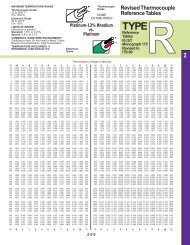Using Thermocouples
Using Thermocouples
Using Thermocouples
Create successful ePaper yourself
Turn your PDF publications into a flip-book with our unique Google optimized e-Paper software.
PRACTICAL THERMOCOUPLE MEASUREMENT<br />
Noise Rejection<br />
C<br />
+<br />
Signal<br />
–<br />
C<br />
(20 Channels)<br />
C<br />
Tree<br />
Switch 1<br />
HI<br />
DVM<br />
Noise<br />
Sour ce<br />
~<br />
C<br />
Next 20 Channels<br />
C<br />
Tree<br />
Switch 2<br />
+<br />
+<br />
Signal<br />
Signal<br />
= ~<br />
–<br />
DVM = –<br />
20 C C HI<br />
Noise<br />
Source<br />
~<br />
Stray capacitance to noise<br />
source is reduced nearly<br />
20:1 by leaving Tree<br />
Switch 2 open.<br />
TREE SWITCHING<br />
Figure 19<br />
~<br />
C<br />
HI<br />
DVM<br />
Tree Switching - Tree switching is a method of<br />
organizing the channels of a scanner into groups, each<br />
with its own main switch.<br />
Without tree switching, every channel can contribute<br />
noise directly through its stray capacitance. With tree<br />
switching, groups of parallel channel capacitances are<br />
in series with a single tree switch capacitance. The<br />
result is greatly reduced crosstalk in a large data<br />
acquisition system, due to the reduced interchannel<br />
capacitance.<br />
Analog Filter - A filter may be used directly at the<br />
input of a voltmeter to reduce noise. It reduces<br />
interference dramatically, but causes the voltmeter to<br />
respond more slowly to step inputs.<br />
Integration - Integration is an A/D technique which<br />
essentially averages noise over a full line cycle; thus,<br />
power line related noise and its harmonics are virtually<br />
eliminated. If the integration period is chosen to be less<br />
than an integer line cycle, its noise rejection properties<br />
are essentially negated.<br />
Since thermocouple circuits that cover long distances<br />
are especially susceptible to power line related noise, it<br />
is advisable to use an integrating analog-to-digital<br />
converter to measure the thermocouple voltage.<br />
Integration is an especially attractive A/D technique in<br />
light of recent innovations which allow reading rates of<br />
48 samples per second with full cycle integration.<br />
V IN<br />
Z-27<br />
Guarding - Guarding is a technique used to reduce<br />
interference from any noise source that is common to<br />
both high and low measurement leads, i.e., from<br />
common mode noise sources.<br />
Let’s assume a thermocouple wire has been pulled<br />
through the same conduit as a 220 Vac supply line. The<br />
capacitance between the power lines and the<br />
thermocouple lines will create an AC signal of<br />
approximately equal magnitude on both thermocouple<br />
wires. This common mode signal is not a problem in an<br />
ideal circuit, but the voltmeter is not ideal. It has some<br />
capacitance between its low terminal and safety ground<br />
(chassis). Current flows through this capacitance and<br />
through the thermocouple lead resistance, creating a<br />
normal mode noise signal. The guard, physically a<br />
floating metal box surrounding the entire voltmeter<br />
circuit, is connected to a shield surrounding the<br />
thermocouple wire, and serves to shunt the interfering<br />
current.<br />
t<br />
ANALOG FILTER<br />
Figure 20<br />
V OUT<br />
t














